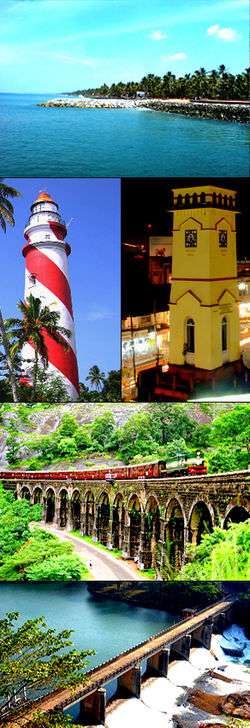Kollam
Kollam (IPA: [koɭɭəm]) ![]()
![]()
Kollam Quilon Coulão | |
|---|---|
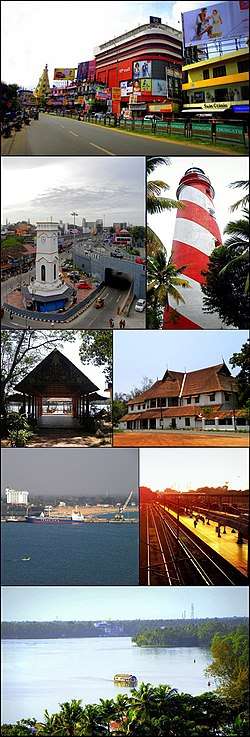 | |
| Etymology: Black pepper: kola ("black pepper") | |
| Nickname(s): Prince of Arabian sea Cashew Capital of the World[1] | |
 Location of the city within Kollam Metropolitan Area | |
 Kollam Location of Kollam in Kerala  Kollam Kollam (India) | |
| Coordinates: 8.88°N 76.60°E | |
| Country | |
| Region | South India |
| State | Kerala |
| District | Kollam |
| Former Name | Quilon, Coulão |
| Native Language | Malayalam |
| Established | 1099 |
| Founded by | Rama Varma Kulashekhara |
| Boroughs | 7 Zones: Central Zone-1, Central Zone-2, Eravipuram, Vadakkevila, Sakthikulangara, Kilikollur, Thrikkadavoor |
| Government | |
| • Type | Mayor–Council |
| • Body | Kollam Municipal Corporation |
| • Mayor | V. Rajendrababu (CPI(M)) |
| • City council | Members
|
| • MP | N.K Premachandran |
| • City Police Commissioner | T. Narayanan IPS |
| Area | |
| • Metropolis | 73.03 km2 (28.20 sq mi) |
| Area rank | 5 |
| Elevation | 3 m (10 ft) |
| Population | |
| • Metropolis | 397,419 |
| • Rank | 4 (49th IN) |
| • Density | 5,400/km2 (14,000/sq mi) |
| • Metro | 1,351,000 |
| Demonym(s) | Kollamite, Kollathukaaran, Kollamkaran |
| Languages | |
| • Official | Malayalam English |
| Time zone | UTC+5:30 (IST) |
| PIN | 691 XXX |
| Telephone code | Kollam-91-474 |
| Vehicle registration | Kollam: KL-02, 23, 24, 25 |
| HDI | High |
| Literacy | 91.18%[6] |
| UN/LOCODE | IN QUI IN KUK |
| Website | www |
V. Nagam Aiya in his Travancore State Manual records that in 822 AD two East Syriac bishops Mar Sabor and Mar Proth, settled in Quilon with their followers. Two years later the Malabar Era began (824 AD) and Quilon became the premier city of the Malabar region ahead of Travancore and Cochin.[17] Kollam Port was founded by Mar Sabor at Tangasseri in 825 as an alternative to reopening the inland seaport of Kore-ke-ni Kollam near Backare (Thevalakara), which was also known as Nelcynda and Tyndis to the Romans and Greeks and as Thondi to the Tamils.[17]

General information
Kollam is an ISO 9001:2015 certified city corporation for the best Municipal administration and services.[18] As per the survey conducted by Economist Intelligence Unit (EIU) based on urban area growth during January 2020, Kollam became the 10th fastest growing city in the world with a 31.1% urban growth between 2015 and 2020.[19] It is a coastal city on the banks of Ashtamudi Lake that took the title God's Own Country. The Ashtamudi Lake lie about 71 kilometres (44 mi) north of the state capital, Thiruvananthapuram. The city hosts the administrative offices of Kollam district and is a prominent trading city for the state. The proportion of females to males in Kollam city is second highest among the 500 most populous cities in India.[20] Kollam is one of the least polluted cities in India.[21]
Four major trading centers around Kollam are Kottarakara, Punalur, Paravur and Karunagapally.
Kollam is an ancient trading town – trading with Romans, Chinese, Arabs and other Orientals – mentioned in historical citations dating back to Biblical times and the reign of Solomon, connecting with Red Sea ports of the Arabian Sea (supported by a find of ancient Roman coins).[22][23] There was also internal trade through the Punalur Pass connecting the ancient town to Tamil Nadu. The overland trade in pepper by bullock cart and the trade over the waterways connecting Allepey and Cochin established trade linkages that enabled it to grow into one of the earliest Indian industrial townships. The rail links later established to Tamil Nadu supported still stronger trade links. The factories processing marine exports and the processing and packaging of cashewnuts extended its trade across the globe.[24]
Major characteristics
Kollam is the fourth largest city in Kerala and the fifth largest in terms of corporation area.[25][26][27][28] It is known for cashew processing and coir manufacturing. Ashtamudi Lake is considered the southern gateway to the backwaters of Kerala and is a prominent tourist destination at Kollam. The Kollam urban area includes suburban towns such as Paravur in the south, Kundara in the east and Karunagapally in the north of the city. Other important towns in the city suburbs are Eravipuram, Kottiyam, Kannanallur and Chavara.
Kollam appeared as Palombe in Mandeville's Travels, where he claimed it contained a Fountain of Youth.[29][30] During the later stages of the rule of the Chera monarchy in Kerala, Kollam emerged as the focal point of trade and politics. Kollam continues to be a major business and commercial center in Southern Kerala.
Toponymy
In 825 CE, the Malayalam calendar, or Kollavarsham, was created in Kollam at meetings held in the city.[31] The present Malayalam calendar is said to have begun with the re-founding of the town, which was rebuilt after its destruction by fire. The name Kollam is believed to have been derived from the Sanskrit word Kollam, meaning pepper.
History
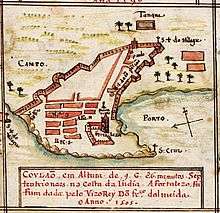
As the ancient city of Quilon, Kollam was a flourishing port during the Chera dynasty (c. 3rd century BC–12th century), and later became the capital of the independent Venad or the Kingdom of Quilon on its foundation in c. 825. Kollam was considered one of the four early entrepots in global sea trade during the 13th century, along with Alexandria and Cairo in Egypt, the Chinese city of Quanzhou, and Malacca in the Malaysian archipelago[32]
Chera rule


Along with (Muziris), Quilon was an ancient seaport on the Malabar Coast of India from the early centuries before the Christian era. The city had a high commercial reputation from the days of the Phoenicians and Ancient Romans. Pliny the Elder (23–79 AD) mentions Greek ships anchored at Muziris and Nelcynda. There was also a land route over the Western Ghats. Spices, pearls, diamonds, and silk were exported to Egypt and Rome from these ports. Pearls and diamonds came to the Chera Kingdom from Ceylon and the southeastern coast of India, then known as the Pandyan Kingdom. Cosmas Indicopleustes, a Greek Nestorian sailor,[33] in his book the Christian Topography[34] who visited the Malabar coast in 550, mentions an enclave of Christian believers in Male (Chera Kingdom). He writes, "In the island of Tabropane (Ceylon), there is a church of Christians, and clerics and faithful. Likewise at Male, where the pepper grows, and in the farming community of Kalliana (Kalliankal at Nillackal) there is also a bishop consecrated in Persia in accordance with the Nicea Sunnahadose of 325 AD."[35] The Nestorian Patriarch Jesujabus, who died in 660 AD, mentions Kollam in his letter to Simon, Metropolitan of Persia.
Capital of Venad (9th to 12th centuries)
The port at Kollam, then known as Quilon, was founded in 825 by the Nestorian Christians Mar Sabor and Mar Proth with sanction from Ayyanadikal Thiruvadikal, the king of the independent Venad or the State of Quilon, a feudatory under the Chera kingdom.[36][37]
It is believed that Mar Sapor Iso also proposed that the Chera king create a new seaport near Kollam in lieu of his request that he rebuild the almost vanished inland seaport at Kollam (kore-ke-ni) near Backare (Thevalakara), also known as Nelcynda and Tyndis to the Romans and Greeks and as Thondi to the Tamils, which had been without trade for several centuries because the Cheras were overrun by the Pallavas in the 6th century, ending the spice trade from the Malabar coast. This allowed the Nestorians to stay in the Chera kingdom for several decades and introduce the Christian faith among the Nampoothiri Vaishnavites and Nair sub-castes in the St. Thomas tradition, with the Syrian liturgy as a basis for the Doctrine of the Trinity, without replacing the Sanskrit and Vedic prayers.[38] The Tharisapalli plates presented to Maruvan Sapor Iso by Ayyanadikal Thiruvadikal granted the Christians the privilege of overseeing foreign trade in the city as well as control over its weights and measures in a move designed to increase Quilon's trade and wealth.[39] The two Christians were also instrumental in founding Christian churches with Syrian liturgy along the Malabar coast, distinct from the ancient Vedic Advaitam propounded by Adi Shankara in the early 9th century among the Nampoothiri Vaishnavites and Nair Sub Castes, as Malayalam was not accepted as a liturgical language until the early 18th century.
Thus began the Malayalam Era, known as Kolla Varsham after the city, indicating the importance of Kollam in the 9th century.[40] The Persian merchant Soleyman of Siraf visited Malabar in the 9th century and found Quilon to be the only port in India used by the huge Chinese ships as their transshipment hub for goods on their way from China to the Persian Gulf. The rulers of Kollam (formerly called 'Desinganadu') had trade relations with China and exchanged embassies. According to the records of the Tang dynasty (618–913),[41] Quilon was their chief port of call before the 7th century. The Chinese trade decreased about 600 and was again revived in the 13th century. Mirabilia Descripta by Bishop Catalani gives a description of life in Kollam, which he saw as the Catholic bishop-designate to Kollam, the oldest Catholic diocese in India. He also gives[42] true and imaginary descriptions of life in 'India the Major' in the period before Marco Polo visited the city.
Portuguese, Dutch and British conquests (16th to 18th centuries)
_-_Autor_desconhecido-cortado.png)
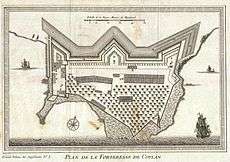
The Portuguese were the first Europeans to establish a trading center in Tangasseri, Kollam in 1502, which became the centre of their trade in pepper.[43] In the wars with the Moors/Arabs that followed, the ancient church (temple) of St Thomas Tradition at Thevalakara was destroyed. In 1517 the Portuguese built the St. Thomas Fort in Thangasseri, which was destroyed in the subsequent wars with the Dutch. In 1661 the Dutch East India Company took possession of the city. The remnants of the old Portuguese Fort, later renovated by the Dutch, can be found at Thangasseri. In the 18th century, Travancore conquered Kollam, followed by the British in 1795.[44] Thangasseri remains today as an Anglo-Indian settlement, though few Anglo-Indians remain. The Infant Jesus Church in Thangasseri, an old Portuguese-built church,[45] remains as a memento of the Portuguese rule of the area.[46][47][48]
Battle of Quilon
The Battle of Quilon was fought in 1809 between a troop of the Indian kingdom of Travancore led by the then Dalawa (prime minister) of Travancore, Velu Thampi Dalawa and the British East India Company led by Colonel Chalmers at Cantonment Maidan in Quilon. The battle lasted for only six hours[49] and was the result of the East India Company's invasion of Quilon and their garrison situated near the Cantonment Maidan. The company forces won the battle while all the insurrectionist who participated in the war were court-martialed and subsequently hanged at the maidan.[50]
Later, Venad Kingdom was completely merged with the Kingdom of Travancore during the rein of Marthanda Varma and Kollam remained as the capital of Travancore Kingdom. The Government Secretariat was also situated in Kollam till the 1830s. It was moved to Thiruvananthapuram during the reign of Swathi Thirunal.[51]
- Excavation at Kollam Port seabed
Excavations are going on at Kollam Port premises since February 2014 as the team has uncovered arrays of antique artifacts, including Chinese porcelain and coins.[52] A Chinese team with the Palace Museum, a team from India with Kerala Council for Historical Research (KCHR) are jointly working at the Kollam Port site for the treasure hunt. The archaeologists and historians said that the discovered coins and artifacts had the potential to tell the story of a bygone India-China link, and even strong trade links of Kollam city with other ancient empires.[53]
Geography

Kollam city is bordered by the panchayats of Neendakara and Thrikkaruva to the north, Mayyanad to the south, and Thrikkovilvattom and Kottamkara to the east, and by the Laccadive Sea to the west. Ashtamudi Lake is in the heart of the city. The city is about 71 kilometres (44 mi) away from Thiruvananthapuram, 140 kilometres (87 mi) away from Kochi and 350 kilometres (220 mi) away from Kozhikode.
The National Waterway 3 and Ithikkara river are two important waterways passing through the city. The 7.7 km long Kollam Canal is connecting Paravur Lake ans Ashtamudi Lake. The Kallada river, another river that flows through the suburbs of the city, empties into Ashtamudi Lake, while the Ithikkara river runs to Paravur Kayal. Kattakayal, a freshwater lake in the city, connects another water-body named Vattakkayal with Lake Ashtamudi.[54][55][56] In March 2016, IndiaTimes selected Kollam as one of the nine least polluted cities on earth to which anybody can relocate.[57] Kollam is one among the top 10 most welcoming places in India for the year 2020, according to Booking.com's traveller review awards.[58]
Climate
Kollam experiences a tropical climate with little seasonal variation in temperatures. December–March is the dry season with less than 60mm of rain in each of those months. April–November is the wet season, with considerably more rain than during December–March.
| Climate data for Kollam | |||||||||||||
|---|---|---|---|---|---|---|---|---|---|---|---|---|---|
| Month | Jan | Feb | Mar | Apr | May | Jun | Jul | Aug | Sep | Oct | Nov | Dec | Year |
| Average high °C (°F) | 31 (88) |
31 (88) |
32 (90) |
32 (90) |
31 (88) |
29 (84) |
29 (84) |
29 (84) |
29 (84) |
30 (86) |
29 (84) |
30 (86) |
30 (86) |
| Average low °C (°F) | 23 (73) |
23 (73) |
25 (77) |
26 (79) |
25 (77) |
24 (75) |
24 (75) |
24 (75) |
24 (75) |
24 (75) |
24 (75) |
23 (73) |
24 (75) |
| Average precipitation mm (inches) | 18 (0.7) |
26 (1.0) |
53 (2.1) |
147 (5.8) |
268 (10.6) |
518 (20.4) |
381 (15.0) |
248 (9.8) |
209 (8.2) |
300 (11.8) |
208 (8.2) |
51 (2.0) |
2,427 (95.6) |
| Average precipitation days (≥ 0.1 mm) | 1 | 2 | 4 | 8 | 11 | 21 | 19 | 16 | 12 | 12 | 8 | 3 | 117 |
| Source: Weather2Travel | |||||||||||||
Demographics
As of the 2011 India census,[4] Kollam city had a population of 349,033 with a density of 5,400 persons per square kilometre. The sex ratio (the number of females per 1,000 males) was 1,112, the highest in the state. The district of Kollam ranked seventh in population in the state while the city of Kollam ranked fourth. As of 2010 Kollam had an average literacy rate of 93.77%,[60] higher than the national average of 74.04%. Male literacy stood at 95.83%, and female at 91.95%. In Kollam, 11% of the population was under six years of age. In May 2015, Government of Kerala have decided to expand City Corporation of Kollam by merging Thrikkadavoor panchayath. So the area will become 73.03 square kilometres (28.20 sq mi) with a total city population of 384,892.[61][62]
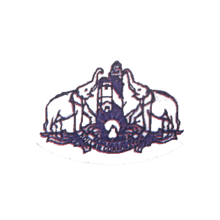
Malayalam is the most widely spoken language and official language of the city, while Tamil is understood by some sections in the city. There are also small communities of Anglo-Indians, Konkani Brahmins, Telugu Chetty and Bengali migrant labourers settled in the city. For ease of administration, Kollam Municipal Corporation is divided into six zones with local zonal offices for each one.[63]
- Central Zone(Headquartered at Cantonment), Kollam Municipal Corporation
- Sakthikulangara Zone, Kollam Municipal Corporation
- Vadakkevila Zone, Kollam Municipal Corporation
- Kilikollur Zone, Kollam Municipal Corporation
- Eravipuram Zone, Kollam Municipal Corporation
- Thrikkadavoor Zone, Kollam Municipal Corporation
In 2014, former Kollam Mayor Mrs. Prasanna Earnest was selected as the Best Lady Mayor of South India by the Rotary Club of Trivandrum Royal[64]
Civic administration

Kollam City is a Municipal Corporation with elected Councillors from its 55 divisions. The Mayor, elected from among the councillors, generally represents the political party holding a majority. The Corporation Secretary heads the office of the corporation.

The present Mayor of Kollam Corporation is Adv.V. Rajendrababu of CPI(M).[65]
The police administration of the city falls under the Kollam City Police Commissionerate which is headed by an IPS (Indian Police Service)cadre officer and he reports to the Inspector General of Police (IGP) Thiruvananthapuram Range. The police administration comes under the State Home Department of the Government of Kerala. Kollam City is divided into three subdivisions, Karunagappally, Kollam and Chathannoor, each under an Assistant Commissioner of Police.
Urban structure
With a total urban population of 1,187,158[66] and 349,033 as city corporation's population, Kollam is the fourth most populous city in the state and 49th on the list of the most populous urban agglomerations in India. As of 2011 the city's urban growth rate of 154.59% was the second highest in the state.[67] The Metropolitan area of Kollam includes Uliyakovil, Adichanalloor, Adinad, Ayanivelikulangara, Chavara, Elampalloor, Eravipuram (Part), Kallelibhagom, Karunagappally, Kollam, Kottamkara, Kulasekharapuram, Mayyanad, Meenad, Nedumpana, Neendakara, Oachira, Panayam, Panmana, Paravur, Perinad, Poothakkulam, Thazhuthala, Thodiyoor, Thrikkadavoor, Thrikkaruva, Thrikkovilvattom, and Vadakkumthala.[68]
The Kerala Government has decided to develop the City of Kollam as a "Port City of Kerala". Regeneration of the Maruthadi-Eravipuram area including construction of facilities for fishing, tourism and entertainment projects will be implemented as part of the project[69]
Industry and economy
The city life of Kollam has changed in the last decade. In terms of economic performance and per capita income, Kollam city is in 5th position from India and third in Kerala.[70] Kollam is famous as a city with excellent export background.[71] 5 star, 4 star and 3 star hotels, multi-storied shopping malls, branded jewellery, textile showrooms and car showrooms have started operations in the city and suburbs. Kollam was the third city in Kerala (after Kozhikode and Kochi) to adopt the shopping mall culture. Kollam district ranks first in livestock wealth in the state. Downtown Kollam is the main CBD of Kollam city.
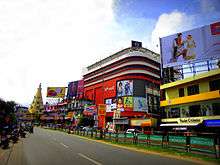
Dairy farming is fairly well developed. Also there is a chilling plant in the city. Kollam is an important maritime and port city. Fishing has a place in the economy of the district. Neendakara and Sakthikulangara villages in the suburbs of the city have fisheries. An estimated 134,973 persons are engaged in fishing and allied activities. Cheriazheekkal, Alappad, Pandarathuruthu, Puthenthura, Neendakara, Thangasseri, Eravipuram and Paravur are eight of the 26 important fishing villages. There are 24 inland fishing villages. The Government has initiated steps for establishing a fishing harbour at Neendakara. Average fish landing is estimated at 85,275 tonnes per year. One-third of the state's fish catch is from Kollam. Nearly 3000 mechanised boats are operating from the fishing harbour. FFDA and VFFDA promote fresh water fish culture and prawn farming respectively. A fishing village with 100 houses is being built at Eravipuram. A prawn farm is being built at Ayiramthengu, and several new hatcheries are planned to cater to the needs of the aquaculturists. Kerala's only turkey farm and a regional poultry farm are at Kureepuzha.[72]
There are two Central Government industrial operations in the city, the Indian Rare Earths, Chavara and Parvathi Mills Ltd., Kollam. Kerala Ceramics Ltd. in Kundara, Kerala Electrical and Allied Engineering Company in Kundara, Kerala Premo Pipe factory in Chavara, Kerala Minerals and Metals Limited in Chavara and United Electrical Industries in Kollam are Kerala Government-owned companies. Other major industries in the private/cooperative sector are Aluminium Industries Ltd. in Kundara, Thomas Stephen & Co. in Kollam, Floorco in Paravur and Cooperative Spinning Mill in Chathannoor.[73] The beach sands of the district have concentrations of such heavy minerals as Ilmenite, Rutile, Monosite and Zircon, which offer scope for exploitation for industrial purposes.
Besides large deposits of China clay in Kundara, Mulavana and Chathannoor, there are also lime-shell deposits in Ashtamudi Lake and Bauxite deposits in Adichanallur.[74]
Known as the "Cashew Capital of the World", Kollam is noted for its traditional cashew business and is home to more than 600 cashew-processing units. Every year, about 800,000 tonnes of raw cashews are imported into the city for processing[75] and an average of 130,000 tonnes of processed cashews are exported to various countries worldwide.[76] The Cashew Export Promotion Council of India (CEPCI) expects a rise in exports to 275,000 tonnes by 2020, an increase of 120 per cent over the current figure.[77] The Kerala State Cashew Development Corporation Limited (KSCDC) is situated at Mundakkal in Kollam city. The company owns 30 cashew factories all across Kerala. Of these, 24 are located in Kollam district.[78][79]
Kollam is one of many seafood export hubs in India with numerous companies involved in the sector. Most of these are based in the Maruthadi, Sakthikulangara, Kavanad, Neendakara, Asramam, Kilikollur, Thirumullavaram and Uliyakovil areas of the city.[80][81] Capithans, Kings Marine Exporters, India Food Exports and Oceanic Fisheries are examples of seafood exporters.[82]
Kollam's Ashtamudi Lake clam fishery was the first Marine Stewardship Council (MSC) certified fishery in India.[83] The clam fishery supports around 3,000 people involved in the collection, cleaning, processing and trading of clams. Around 90 species of fish and ten species of clams are found in the lake.
Transport
Air
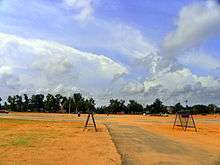
The city corporation of Kollam is served by the Trivandrum International Airport, which is about 56 kilometers from the city. Trivandrum International Airport is the first international airport in a non-metro city in India.[84] and the only airport in Kerala having more than 2 Terminals. Daily domestic flight services are available such major cities as Mumbai, Hyderabad, Chennai, Visakhapatnam, Delhi, Bangalore and Kochi. International flight services connecting to Sharjah, Dubai, Abu Dhabi, Bahrain, Kuwait, Muscat, Malé, Doha, Singapore and Colombo are available from here.
However, Kollam Airport at Asramam was the first aerodrome in Kerala. The first flight to Kerala landed here. Now the old airport area is serving as a twin-helipad of the city, which is about 1 km away from the city center.[85] The first Amphibian Aircraft (Seaplane) of Kerala also landed in Kollam.
Rail
Kollam Junction is the second largest railway station in Kerala in area, after Trivandrum Central, with a total of 6 platforms. The station has 17 rail tracks. Kollam junction has world's second longest railway platform, measuring 1180.5 m(3873 ft).[86] Mainline Electrical Multiple Unit(MEMU) have a maintenance shed at Kollam Junction. The MEMU services started from Kollam to Ernakulam via Alappuzha and Kottayam in the 2nd week of January 2012.[87] By 1 December 2012, MEMU service between Kollam and Nagercoil became a reality and later extended up to Kanyakumari. Kollam MEMU Shed inaugurated on 1 December 2013 for the maintenance works of MEMU rakes. Kollam MEMU Shed is the largest MEMU Shed in Kerala, which is equipped with most modern facilities. There is a long-standing demand for the Kollam Town Railway Station in the Kollam-Perinad stretch and "S.N College Railway Station" in the Kollam-Eravipuram stretch. The railway stations in Kollam city are Kollam Junction railway station, Eravipuram railway station and Kilikollur railway station.
A new suburban rail system has been proposed by the Kerala Government and Indian Railways on the route Thiruvananthapuram - Kollam - Haripad/Chengannur for which MRVC is tasked to conduct a study and submit a report. Ten trains, each with seven coaches, will transport passengers back and forth along the Trivandrum-Kollam-Chengannur-Kottarakara-Adoor section.[88]
Road
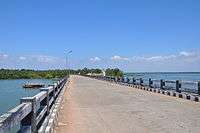
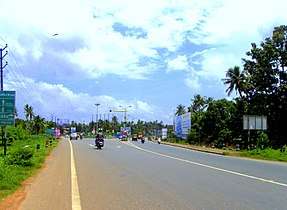
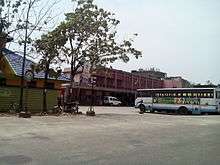
The city of Kollam is connected to almost all the cities and major towns in the state, including Trivandrum, Alappuzha, Kochi, Palakkad, Kottayam, Kottarakkara, and Punalur, and with other Indian cities through the NH 66, NH 183, NH 744 - and other state PWD Roads. Road transport is provided by state-owned Kerala State Road Transport Corporation (KSRTC)and private transport bus operators. Kollam is one among the five KSRTC zones in Kerala.[89] Road transport is also provided by private taxis and autorickshaws, also called autos. There is a city private bus stand at Andamukkam. There is a KSRTC bus station beside Ashtamudi Lake. Buses to various towns in Kerala and interstate services run from this station.[90]
Water
The State Water Transport Department operates boat services to West Kallada, Munroe Island, Guhanandapuram, Dalavapuram and Alappuzha from Kollam KSWTD Ferry Terminal situated on the banks of the Ashtamudi Lake. Asramam Link Road in the city passes adjacent to the ferry terminal.[91]
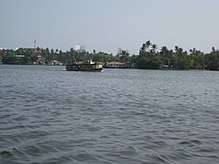
Double decker luxury boats run between Kollam and Allepey daily. Luxury boats, operated by the government and private owners, operate from the main boat jetty during the tourist season. The West coast canal system, which starts from Thiruvananthapuram in the south and ends at Hosdurg in the north, passes through Paravur, the city of Kollam and Karunagappally taluk.[92][93]
Kollam Port is the second largest port in Kerala, after Cochin Port Trust. It is one of two international ports in Kerala. Cargo handling facilities began operation in 2013.[94] Foreign ships arrive in the port regularly with the MV Alina, a 145-metre (476 ft) vessel registered in Antigua anchored at the port on 4 April 2014.[95] Once the Port starts functioning in full-fledged, it will make the transportation activities of Kollam-based cashew companies more easy.[96] Shreyas Shipping Company is now running a regular container service between Kollam Port and Kochi Port.[97][98]
Education
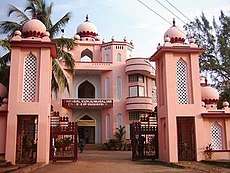
There are many respected colleges, schools and learning centres in Kollam. The city and suburbs contribute greatly to education by providing the best and latest knowledge to the scholars. The Thangal Kunju Musaliar College of Engineering, the first private school of its kind in the state, is at Kilikollur, about 7 kilometres (4.3 mi) east of Kollam city, and is a source of pride for all Kollamites. The Government of Kerala has granted academic autonomy to Fatima Mata National College, another prestigious institution in the city.[99] Sree Narayana College, Bishop Jerome Institute (an integrated campus providing Architecture, Engineering and Management courses), and Travancore Business Academy are other important colleges in the city. There are two law colleges in the city, Sree Narayana Guru College of Legal Studies under the control of Sree Narayana Trust and N S S Law College managed by the N.S.S. There are also some best schools in Kollam including Trinity Lyceum School, Infant Jesus School, St Aloysius H.S.S, The oxford school etc.
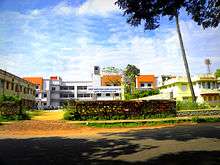
Kerala State Institute of Design (KSID), a design institute under Department of labour and Skills, Government of Kerala, is located at Chandanathope in Kollam. It was established in 2008 and was one of the first state-owned design institutes in India. KSID currently conducts Post Graduate Diploma Programs in Design developed in association with National Institute of Design, Ahmedabad.[100][101]
Indian Institute of Infrastructure and Construction(IIIC-Kollam) is an institute of international standards situated at Chavara in Kollam city to support the skill development programmes for construction related occupations.[102] The Institute of Fashion Technology, Kollam, Kerala is a fashion technology institute situated at Vellimon, established in technical collaboration with the National Institute of Fashion Technology and the Ministry of Textiles. In addition, there are two IMK (Institute of Management, Kerala) Extension Centres active in the city.[103] Kerala Maritime Institute is situated at Neendakara in Kollam city to give maritime training for the students in Kerala.[104] More than 5,000 students have been trained at Neendakara maritime institute under the Boat Crew training programme.[105]
Apart from colleges, there are a number of bank coaching centres in Kollam.[106] Kollam is known as India's hub for bank test coaching centres with around 40 such institutes in the district.[107] Students from various Indian states such as Tamil Nadu, Karnataka, Andhra Pradesh, Bihar and Madhya Pradesh also come here for coaching.
Culture
Kollam Fest is Kollam's own annual festival, attracting mostly Keralites but also hundreds of domestic and foreign tourists to Kollam. The main venue of Kollam Fest is the historic and gigantic Ashramam Maidan. Kollam Fest is the signature event of Kollam. Kollam Fest seeks to showcase Kollam's rich culture and heritage, tourism potential and investments in new ventures.[108]
Kollam Pooram, part of the Ashramam Sree Krishnaswamy Temple Festival, is usually held on 15 April, but occasionally on 16 April. The pooram is held at the Ashramam maidan.
The President's Trophy Boat Race (PTBR) is an annual regatta held in Ashtamudi Lake in Kollam. The event was inaugurated by President Prathibha Patil in September 2011. The event has been rescheduled from 2012.[109][110]
Sports
Cricket is the most popular sport, followed by hockey and football. Kollam is home to a number of local cricket, hockey and football teams participating in district, state-level and zone matches. An International Hockey Stadium with astro-turf facility is there at Asramam in the city, built at a cost of Rs. 13 crore.[111] The land for the construction of the stadium was taken over from the Postal Department at Asramam, Kollam. The city has another stadium named the Lal Bahadur Shastri Stadium, Kollam. It is a multipurpose stadium and has repeatedly hosted such sports events as the Ranji Trophy, Santhosh Trophy and National Games.[112] Two open grounds in the city, the Asramam Maidan and Peeranki Maidan, are also used for sports events, practice and warm-up matches.
Places of worship
The city of Kollam is a microcosm of Kerala state and its residents belong to varied religious, ethnic and linguistic groups.[113] There are so many ancient temples, centuries-old churches and mosques in the city and its suburbs.
- Hindus and temples
.jpg)
Kollam is a Hindu majority city in Kerala. 56.35% of Kollam's total population belongs to Hindu community. Moreover, the Kollam Era (also known as Malayalam Era or Kollavarsham or Malayalam Calendar or Malabar Era), solar and sidereal Hindu calendar used in Kerala, has been originated on 825 CE (Pothu Varsham) at (Kollam) city.[114][115][116]
Anandavalleeshwaram Sri Mahadevar Temple is a 400 years old ancient Hindu temple in the city. The 400-year-old Sanctum sanctorum of this temple is finished in teak.[117] Ammachiveedu Muhurthi temple is another major temple in the city that have been founded around 600 years ago by the Ammachi Veedu family, aristocrats from Kollam.[118][119] The Kollam pooram, a major festival of Kollam, is the culmination of a ten-day festival, normally in mid April, of Asramam Sree Krishna Swamy Temple.[120] Kottankulangara Devi Temple is one of the world-famous Hindu temples in Kerala were cross-dressing of men for Chamayavilakku ritual is a part of traditional festivities. The men also carry large lamps. The first of the two-day dressing event drew to a close early on Monday.[121] Moreover, Kottarakkara Sree Mahaganapathi Kshethram in Kottarakkara,[122] Puttingal Devi Temple in Paravur,[123] Poruvazhy Peruviruthy Malanada Temple in Poruvazhy,[124] Sasthamcotta Sree Dharma Sastha Temple in Sasthamkotta,[125] Sakthikulangara Sree Dharma Sastha temple, Thrikkadavoor Sree Mahadeva Temple in Kadavoor and Kattil Mekkathil Devi Temple in Ponmana[126] are the other famous Hindu worship centres in the Kollam Metropolitan Area.[127]
- Christianity and churches
Christians account for 21.17% of the total population of Kollam city.[128] The Roman Catholic Diocese of Quilon or Kollam is the first Catholic diocese in India. The diocese, which covers an area of 1,950 km2 (750 sq mi) and contains a population of 4,879,553 – 235,922 (4.8%) of whom are Catholic – is claimed to have first been erected on 9 August 1329. It was re-erected on 1 September 1886. The famous Infant Jesus Cathedral, 400 years old, located in Thangassery, is the co-cathedral of the Roman Catholic Diocese of Quilon.[129] CSI Kollam-Kottarakara Diocese is one of the twenty-four dioceses of the Church of South India.[130]
The Infant Jesus Cathedral in Tangasseri is established by Portuguese during 1614. It is now the pro-cathedral of Roman Catholic Diocese of Quilon – the ancient and first Catholic diocese of India. The church remains as a memento of the Portuguese rule of old Quilon city.[131] St. Sebastian's Church at Neendakara is another important church in the city. The Dutch Church in Munroe Island is built by the Dutch in 1878.[132] Our Lady of Velankanni Shrine in Cutchery is another important Christian worship place in Kollam city. Saint Casimir Church in Kadavoor,[133] Holy Family Church in Kavanad, St.Stephen's Church in Thoppu[134] and St.Thomas Church in Kadappakada are some of the other major Christian churches in Kollam.[135][136]
- Muslims and mosques

Muslims accounts 22.05% of Kollam's total population. As per the Census 2011 data, 80,935 is the total Muslim population in Kollam.[137] The Karbala Maidan and the adjacent Makani mosque serves as the Eid gah for the city. The 300-year-old Juma-'Ath Palli at Karuva houses the mortal remains of a Sufi saint, Syed Abdur Rahman Jifri.[138][139]
Kottukadu Juma Masjid in Chavara, Elampalloor Juma-A-Masjid, Valiyapalli in Jonakappuram, Chinnakada Juma Masjid, Juma-'Ath Palli in Kollurvila, Juma-'Ath Palli in Thattamala and Koivila Juma Masjid in Chavara are the other major Mosques in Kollam.[140][141]
Notable people
Notable individuals born in Kollam include:
- Mahakavi K.C Kesava Pillai, Malayalam poet
- C. Kesavan, Chief Minister of erstwhile Travancore
- Elamkulam Kunjan Pillai, historian and scholar
- R. Sankar, former Chief Minister of Kerala
- Paravur Devarajan, Malayalam music director
- Thirunalloor Karunakaran, poet
- O. N. V. Kurup, Malayalam poet and lyricist
- K. Balakrishnan, Writer, politician, journalist
- K. Surendran, Novelist
- V. Sambasivan, Kathaprasangam artist
- O. Madhavan, theatre personality
- Shaji N Karun, Malayalam movie director
- Murali, Malayalam movie actor
- Thangal Kunju Musaliar, industrialist & educational visionary
- Kollam Thulasi, actor
- Kollam G. K. Pillai, actor
- Jayan, a film actor and Indian Navy officer
- P. K. Gurudasan, politician and MLA
- James Albert, screenwriter and director
- Suresh Gopi, actor
- Pamman (R. Parameswara Menon), novelist
- Mukesh, Malayalam film actor
- Resul Pookutty,Oscar Award winner, Sound engineer
- Kalpana, actress
- Urvashi, actress
- Kalaranjini, actress
- Tinu Yohannan, international cricket
- Olympian T. C. Yohannan, athlet.
- Ambili Devi, Malayalam film actress
- Rajan Pillai, businessman
- B. Ravi Pillai, businessman
- Kundara Johnny, film actor
- K. Ravindran Nair (Achani Ravi), film producer
- M. A. Baby, politician
- Baby John, politician
- Matha Amrithananda Mayi, spiritual leader
See also
- Downtown Kollam
- Kollam Junction railway station
- Kollam Metropolitan Area
- Kollam District
- Cashew business in Kollam
References
- "Kollam's cashew crunch". The Hindu. 28 April 2018. Retrieved 10 August 2018.
- "Population Finder - Census of India 2011". Government of India.
- "Thrikkadavoor panchayath". Government of Kerala.
- Census March 1, 2001 (via archive.org)
- "Demographia World Urban Areas" (PDF). Demographia. Retrieved 23 April 2016.
- "Provisional Population Totals, Census of India 2011; Cities having population 1 lakh and above" (PDF). Office of the Registrar General & Census Commissioner, India.
- "East Is West And Up Is Really Down". mid-day.com. Retrieved 14 January 2020.
- "Kollam - Encyclopaedia Britannica". Britannica. Retrieved 7 February 2020.
- "Kollam on the itinerary". The Hindu. 14 September 2018. Retrieved 14 September 2018.
- Cities of Kerala
- Kerala Cities
- Alphabetical listing of Places in State of Kerala
- Sastri, K. A. Nilakanta (1958) [1935]. History of South India (2nd ed.). Oxford University Press.
- "Kozhikode to China: IIT Prof Unearths 700-YO Link That'll Will Blow Your Mind!". The Better India. 26 July 2018. Retrieved 7 December 2015.
- Kollam - Mathrubhumi Archived 9 October 2014 at the Wayback Machine
- Short History of Kollam
- Aiyya, V.V Nagom, State Manual p. 244
- "Kollam Corporation achieved ISO Certification". 17 May 2019. Retrieved 18 June 2019.
- "3 of world's 10 fastest-growing urban areas are in Kerala: Economist ranking". 8 January 2020. Retrieved 8 January 2020.
- "census2011.co.in - Indian Cities". Retrieved 7 December 2015.
- "The 4 Least Polluted Cities in India - India.com". 7 December 2015. Retrieved 7 December 2015.
- "The legendary beauty of Kollam".
- "History of Kollam". Archived from the original on 2 June 2015.
- "Kollam Tourism - Official Website". Retrieved 6 January 2014.
- "Trivandrum city Corporation". Trivandrum city Corporation. Retrieved 23 November 2014.
- "Kochi city Corporation". Kochi city Corporation. Archived from the original on 17 July 2015. Retrieved 23 November 2014.
- "Kozhikode city Corporation". Kozhikode city Corporation. Retrieved 23 November 2014.
- "Thrissur city Corporation". Thrissur city Corporation. Retrieved 23 November 2014.
- Mandeville, John. The Travels of Sir John Mandeville. Accessed 24 September 2011.
- Kohanski, Tamarah & Benson, C. David (Eds.) The Book of John Mandeville. Medieval Institute Publications (Kalamazoo), 2007. Op. cit. "Indexed Glossary of Proper Names". Accessed 24 September 2011.
- ending with the Royal sanction of Tarissapalli copper plates to Assyrian Monks by Vaishnaite Chera King Rajashekara Varma, against the backdrop of a Shivite revival led by Adi Shankara among the Nampoothiri communities Kerala government website Archived 21 November 2007 at the Wayback Machine
- tignor, Robert (2010). Worlds together, worlds apart: a history of the world from the beginnings of humankind to the present (3rd ed.). New York: W.W. Norton & Co. p. 365. ISBN 978-0-393-93492-2.
- Roger Pearse (5 July 2003). "Cosmas Indicopleustes, Christian Topography. Preface to the online edition". Ccel.org. Retrieved 20 April 2013.
- Roger Pearse. "Cosmas Indicopleustes, Christian Topography (1897) pp. 358–373. Book 11". Ccel.org. Retrieved 20 April 2013.
- Travancore Manual
- Kerala Charithram P.59 Sridhara Menon
- V. Nagam Aiya (1906), Travancore State Manual, page 244
- History of Kollam city and Kollam Port Quilon.com
- Yogesh Sharma (2010). Coastal Histories: Society and Ecology in Pre-modern India. Primus Books. p. 78. ISBN 978-93-80607-00-9.
- Pius Malekandathil (2010). Maritime India: Trade, Religion and Polity in the Indian Ocean. Primus Books. p. 43. ISBN 978-93-80607-01-6.
- Travancore Manual, page 244
- Mirabilia Descripta by Jordanus Catalani circa 1320–1336 (trans Hiracut Society, London)
- Thangassery, Kollam - Kerala Tourism
- About the City of Kollam Archived 2 June 2015 at the Wayback Machine
- New proof for Pre-Portuguese mission in Kollam
- "Tourmet - Thangassery, Kollam". Retrieved 6 January 2014.
- "History of Kollam". Retrieved 15 January 2014.
- 'Jornada' of Portuguese Bishop Dom Alexis Menezes 1599–1600AD
- E-book:History of Travancore by P. Shangoony Menon. Retrieved 5 November 2014.
- A place in history
- "A short history of the Kerala Secretariat as building celebrates 150 years". The NEWS Minute. 5 November 2019. Retrieved 6 November 2019.
- "Emergence of antiques triggers treasure hunt in Kollam". The Hindu. 21 February 2014. Retrieved 11 January 2017.
- "Chinese-Indian joint archaeological team discovers Chinese cultural relics in India". CCTV.com. 9 January 2017. Retrieved 11 January 2017.
- "A stream fading into historyg - The Hindu". 20 September 2004. Retrieved 23 January 2020.
- "Maruthadi - Maruthadi.Elisting.in". Retrieved 23 January 2020.
- "Water Resources - Government of Kerala". 7 March 2015. Retrieved 23 January 2020.
- "9 of the Least Polluted Cities on Earth You Could Consider Moving To". Indiatimes. Retrieved 21 March 2016.
- "For 2nd year in row, Kerala tops list of most welcoming places: Report". Financial Express. 22 January 2020. Retrieved 23 January 2020.
- "Kollam City Census 2011 data". Census2011. Retrieved 27 January 2016.
- "Kollam District". kollam.nic.in. Retrieved 24 June 2010.
- "Thrikadavur becomes part of Kollam city". The Hindu. Retrieved 11 June 2015.
- "Thrikadavur Panchayath". Thrikadavur Panchayath. Retrieved 11 June 2015.
- "Building Permit Management System -Kollam Corporation". Retrieved 16 December 2014.
- "Award for Kollam Mayor". The Hindu. 3 April 2014. Retrieved 6 June 2014.
- "CPI(M) rides to power in five of six corporations in Kerala". The Economic Times. 18 November 2015. Retrieved 25 November 2015.
- "Kollam District Level Statistics 2011" (PDF). ecostat.kerala.gov.in. 2012. Retrieved 1 January 2014.
- "ANALYSIS OF CENSUS DATA - Census of India Website" (PDF). censusindia.gov.in.
- "Kollam city population Census". census2011.co.in. Retrieved 16 December 2013.
- "Kollam - Port City Project". 2013.
- "Delhi ranked 23rd in mega survey of 53 Indian cities". Hindustan Times. 14 June 2015. Retrieved 26 June 2015.
- "APPENDICES AND AAYAT NIRYAT FORMS" (PDF). Govt. of India. Retrieved 1 July 2015.
- Department of Animal Husbandry - Kerala
- Kollam - Trade & Commerce
- resources - Kollam
- "Archived copy". Archived from the original on 22 October 2014. Retrieved 14 November 2014.CS1 maint: archived copy as title (link) Online Customs Clearance Facility for Kollam Port to be ready in a month
- Rise in earnings from cashew kernel exports - The Hindu
- CEPCI - Kollam
- ":: KSCDC ::". Cashewcorporation.com. Archived from the original on 15 February 2015. Retrieved 26 August 2014.
- ":: The Kerala State Cashew Development Corporation Limited ::". Cashewcorporation.com. Retrieved 29 July 2014.
- Kerala Exporters
- "Archived copy". Archived from the original on 4 March 2016. Retrieved 17 November 2014.CS1 maint: archived copy as title (link) Kollam - Marine Food Exporters
- Registered Kerala Exporters
- "Ashtamudi short-neck clam fisheries becomes India's first MSC certified fisheries". Indian Council of Agricultural Research. 5 November 2014. Retrieved 16 May 2015.
- "TRV Airport". AAI. Archived from the original on 2 September 2016. Retrieved 23 August 2016.
- "Aviation school proposal evokes mixed response". The Hindu. 8 June 2009. Retrieved 23 August 2016.
- "West Bengal: tea plantations and other Raj-era relics". Retrieved 3 April 2019.
- "Timings of MEMUs included". The New Indian Express. 2 July 2010. Retrieved 9 August 2016.
- "New DRM optimistic about suburban project - KERALA". The Hindu. Retrieved 13 January 2018.
- "Thiruvananthapuram: KSRTC executive directors in-charge of zones". The Times of India. 8 January 2017. Retrieved 9 January 2017.
- "National Highways in Kerala". Kerala PWD. Retrieved 9 August 2016.
- "Kerala State Water Transport Department - Introduction". KSWTD. Retrieved 4 January 2015.
- "Transport - Kollam Corporation". Kollam Municipal Corporation. Retrieved 4 January 2015.
- "Important places enroute - KSWTD". KSWTD. Retrieved 4 January 2015.
- Kollam port starts cargo handling. Accessed 29 July 2014.
- "Foreign Ship Reaches Kollam Port". The New Indian Express. 5 April 2014. Retrieved 7 April 2014.
- Kollam cashew importers suffering due to port congestion at tuticorin terminal. Accessed 29 July 2014.
- Shreyas Shipping starts Kochi-Kollam container service. Accessed 29 July 2014.
- Shreyas Shipping inaugurates Kollam port with new service. Accessed 29 July 2014.
- "Autonomy: 13 colleges in the list". The New Indian Express. 2012. Retrieved 8 January 2014.
- "Admission Process Starts at KSID for New Diploma Courses".
- "Institute of design inaugurated".
- "States-Ministry of Skill Development & Entrepreneurship". Government of India. Retrieved 27 November 2019.
- "IMK Extension Centres - Kerala". imk.ac.in. 2012. Retrieved 8 January 2014.
- "Maritime institute to come up at Neendakara". The Hindu. Retrieved 27 November 2019.
- "Steps begun to set up Maritime university". The New Indian Express. 8 May 2013. Retrieved 27 November 2019.
- "Which is the best banking coaching centre in India - Kollam". Retrieved 9 August 2014.
- "Engineering graduates opt for banking sector". Times of India. Retrieved 9 August 2014.
- "Kollam Fest 10 November 2011". Thiraseela.com. Retrieved 3 March 2016.
- "presidents trophy boat race". Presidentstrophy.gov.in. Retrieved 20 April 2013.
- "President's Trophy boat race on November 1". The Hindu. 24 October 2016. Retrieved 20 April 2013.
- "Astro-turf hockey stadium". The New Indian Express. Retrieved 22 February 2018.
- "KCA-Cricket Archive". Cricket Archive. Retrieved 22 February 2018.
- Menon, A Sreedhara; "A Survey of Kerala History"; DC Books, 1 January 2007 – History – pp 54–56
- "Kollam Era" (PDF). Indian Journal History of Science. Archived from the original (PDF) on 27 May 2015. Retrieved 30 December 2014.
- Broughton Richmond (1956), Time measurement and calendar construction, p. 218
- R. Leela Devi (1986). History of Kerala. Vidyarthi Mithram Press & Book Depot. p. 408.
- "400-year-old sreekovil to be replaced". The Hindu. Retrieved 13 October 2015.
- Ammachiveedu Muhurthi Temple at kollamcity.com
- Ammachiveedu Muhurthi Temple at thekeralatemples.com
- News article regarding kollam pooram
- "Kerala temple: Where the lady with the lamp is a man". NDTV. Retrieved 25 March 2013.
- "Of small appam and Kottarakkara". Mathrubhumi. Retrieved 25 March 2013.
- "Puttingal Devi Temple, Paravur". Puttingal Devi Temple. Retrieved 25 March 2013.
- "Malanada temple fete draws big crowds". The Hindu. Retrieved 25 March 2013.
- "Sasthamcotta Sree Dharma Sastha Temple". Sasthamcotta Sree Dharma Sastha Temple. Retrieved 25 March 2013.
- "Here, bells on tree answer your prayers". Deccan Chronicle. Retrieved 25 March 2013.
- "No permission for RSS to conduct 'shakha' in temple: Kerala HC told". The Times of India. Retrieved 25 March 2013.
- "Kollam City Census 2011 data". Census2011. Retrieved 25 March 2013.
- "Roman Catholic Diocese of Quilon". Kollam Diocese. Retrieved 25 March 2013.
- "CSI Redraws Borders of Dioceses". The New Indian Express. Retrieved 19 January 2016.
- "About Kollam City". Kollam, India. Archived from the original on 2 June 2015. Retrieved 19 January 2016.
About the city of Quilon
- "The emerald isle". The Hindu. Retrieved 19 January 2016.
- "Church festival from Saturday". The Hindu. Retrieved 19 January 2016.
- "St.Stephen's Church". Kollam St.Stephen's Church. Retrieved 19 January 2016.
- "St.Thomas Church". The Hindu. Retrieved 19 January 2016.
- "Piety marks Good Friday observance". The Hindu. Retrieved 19 January 2016.
- "Population of Kollam City - Census 2011 data". Census2011. Retrieved 25 March 2013.
- "Important religious centres in Kollam". Retrieved 6 January 2014.
- "Juma-Ath-Mosque". Retrieved 29 July 2014.
- "Juma-Ath-Palli". Retrieved 29 July 2014.
- "Elampalloor Juma-A-Masjid". Retrieved 29 July 2014.
Bibliography
- Ring, Trudy (1994). International Dictionary of Historic Places: Asia and Oceania, Volume 5. United Kingdom: Taylor & Francis. ISBN 978-1-884964-05-3.
- Chan, Hok-lam (1998). "The Chien-wen, Yung-lo, Hung-hsi, and Hsüan-te reigns, 1399–1435". The Cambridge History of China, Volume 7: The Ming Dynasty, 1368–1644, Part 1. Cambridge: Cambridge University Press. ISBN 978-0-521-24332-2.
- Lin (2007). Zheng He's Voyages Down the Western Seas. Fujian Province: China Intercontinental Press. ISBN 978-7-5085-0707-1.
- Elamkulam Kunjan Pillai, Keralathinde Eruladanja Edukal, p. 64,112,117
- Travancore Archaeological Series (T.A.S.) Vol. 6 p. 15
- Diaries and writings of Mathai Kathanar, the 24th generation priest of Thulaserry Manapurathu, based on the ancestral documents and Thaliyolagrandha handed down through generations
- Z.M. Paret, Malankara Nazranikal, vol. 1
- L. K. Ananthakrishna Iyer, State Manual, p50,52
- Bernard Thoma Kathanar, Marthoma Christyanikal, lines 23,24
- Narayan, M.G.S, Chera-Pandya conflict in the 8th–9th centuries which led to the birth of Venad: Pandyan History seminar, Madurai University, 1971
- The Viswavijnanakosam (Malayalam) Vol. 3, p. 523,534
- Narayan M.G.S., Cultural Symbiosis p33
- The handwritten diaries of Pulikottil Mar Dionyius (former supreme head of the Malankara Orthodox Syrian Church and Chitramezhuthu KM Varghese)
External links
| Wikimedia Commons has media related to Kollam. |

- Official website

